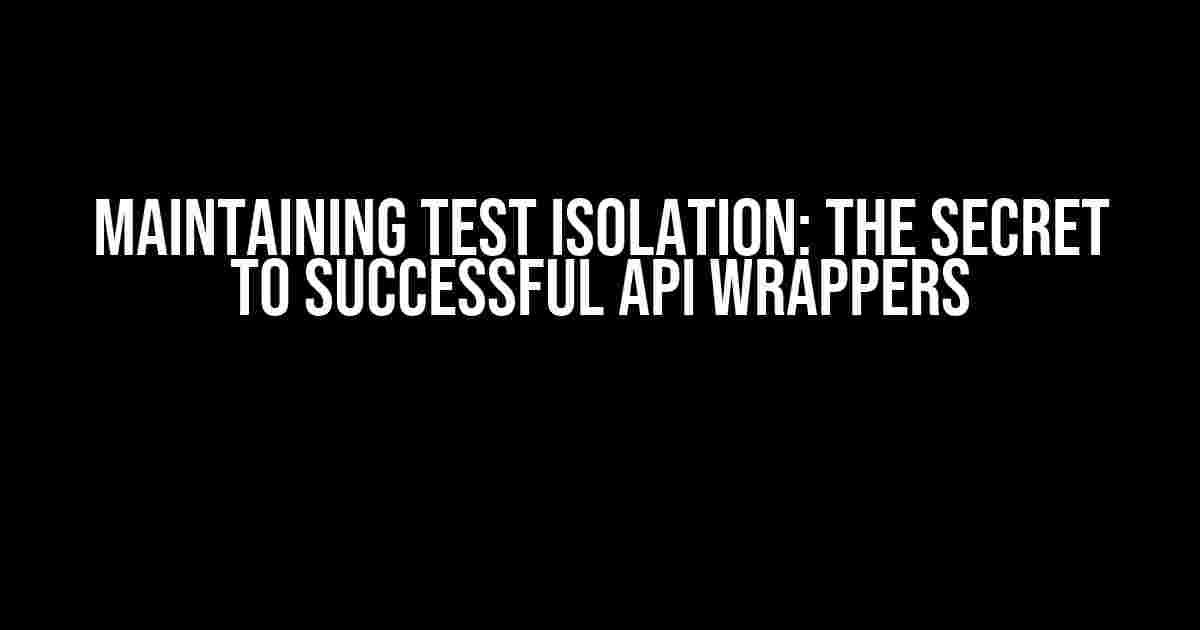When it comes to testing API wrappers, it’s essential to maintain test isolation to ensure that your tests are reliable, efficient, and scalable. In this article, we’ll explore the importance of maintaining test isolation and provide practical guidance on how to achieve it.
Why Test Isolation Matters
Test isolation is critical because it allows you to test individual components of your system in isolation, without interfering with other components. When you test implementation with API wrappers, you’re essentially testing multiple components simultaneously, which can lead to:
- False positives: Tests may pass or fail due to issues in other components, rather than the component being tested.
- False negatives: Tests may not detect issues in the component being tested due to interference from other components.
- Test flakiness: Tests may produce inconsistent results, making it difficult to diagnose and resolve issues.
- Increased test maintenance: Tests that are tightly coupled to implementation details may break frequently, requiring excessive maintenance.
The Dangers of Testing Implementation with API Wrappers
When you test implementation with API wrappers, you’re essentially testing the internal workings of the API, rather than its external behavior. This can lead to:
- Tight coupling: Tests become tightly coupled to the implementation details of the API, making them fragile and prone to breaking.
- Over-testing: You may end up testing unnecessary implementation details, increasing test complexity and maintenance.
- Under-testing: You may not test the external behavior of the API thoroughly, leading to missed bugs and issues.
Best Practices for Maintaining Test Isolation
To maintain test isolation, follow these best practices:
-
Use Mocks and Stubs
Mocks and stubs allow you to isolate dependencies and control the behavior of external components. This enables you to focus on testing the component in isolation, without worrying about external factors.
// Example using Jest
jest.mock('axios', () => ({
get: () => Promise.resolve({ data: 'mocked response' }),
}));
-
Test API Endpoints in Isolation
Test individual API endpoints in isolation, using mock data or stubs to control the behavior of dependencies.
// Example using Cypress cy.intercept('GET', 'https://api.example.com/users', { fixture: 'users.json', }).as('getUser'); -
Use Service Layers or Abstractions
Service layers or abstractions provide a clear separation between the API wrapper and the underlying implementation. This enables you to test the API wrapper in isolation, without worrying about the implementation details.
API Wrapper Service Layer Implementation public async getUser() private async _getUser() axios.get(‘https://api.example.com/users’) -
Avoid Over-Engineering
Avoid over-engineering your tests by focusing on the external behavior of the API wrapper, rather than its internal implementation details.
-
Keep Tests Simple and Focused
Keep your tests simple and focused on a specific scenario or behavior. This helps to maintain test isolation and reduces the likelihood of test flakiness.
Common Pitfalls to Avoid
When maintaining test isolation, it’s essential to avoid common pitfalls, such as:
- Using too many mocks or stubs, which can lead to over-testing and increased test complexity.
- Over-engineering tests, which can lead to tight coupling and test fragility.
- Not testing the external behavior of the API wrapper, leading to missed bugs and issues.
- Not using service layers or abstractions, which can lead to tight coupling between the API wrapper and the implementation.
Conclusion
Maintaining test isolation is crucial when testing API wrappers. By following best practices, such as using mocks and stubs, testing API endpoints in isolation, using service layers or abstractions, and avoiding over-engineering, you can ensure that your tests are reliable, efficient, and scalable.
Remember, testing implementation with API wrappers can lead to false positives, false negatives, test flakiness, and increased test maintenance. By maintaining test isolation, you can focus on testing the external behavior of the API wrapper, rather than its internal implementation details.
By following these guidelines, you can ensure that your API wrappers are thoroughly tested, and your development team can build a more robust and reliable software system.
So, how do you maintain test isolation in your API wrapper tests? Share your best practices and experiences in the comments below!
Frequently Asked Question
Get the inside scoop on maintaining test isolation and avoiding the common pitfall of testing implementation with API wrappers!
What’s the importance of maintaining test isolation?
Maintaining test isolation is crucial because it ensures that each test is independent and doesn’t interfere with other tests. This isolation prevents test pollution, where one test’s setup or teardown affects another test’s outcome, leading to false positives or negatives. Isolated tests give you confidence in your test results, allowing you to identify and fix issues more efficiently.
Why is it a bad idea to test implementation with API wrappers?
Testing implementation with API wrappers is a no-no because it tightly couples your tests to the implementation details of the API. This makes your tests brittle and prone to breaking when the API changes. Instead, focus on testing the API’s contracts, such as the inputs, outputs, and behavior. This decouples your tests from the implementation, making them more robust and maintainable.
How do I ensure my tests are isolated when using mocks?
When using mocks, make sure to reset or recreate them between tests to avoid state leakage. You can also use mocking libraries that provide features like automatic mock reset or scoped mocks. Additionally, consider using a testing framework that supports test isolation, such as Jest or Pytest, which provide built-in support for isolating tests.
What are some common signs of testing implementation with API wrappers?
Red flags include tests that are tightly coupled to specific API implementations, such as testing internal methods or variables. Other signs include tests that are overly dependent on the API’s implementation details, like mocking internal dependencies or using API-specific error codes. If you notice these signs, it’s time to refactor your tests to focus on the API’s contracts instead!
How can I refactor my tests to maintain test isolation and avoid API wrapper pitfalls?
Start by identifying the API’s contracts, such as the inputs, outputs, and behavior. Then, refactor your tests to focus on these contracts, using mocks and stubs to isolate the API’s dependencies. Finally, use testing best practices like the Arrange-Act-Assert pattern and keep your tests simple, focused, and independent. With these tips, you’ll be well on your way to maintaining test isolation and avoiding API wrapper pitfalls!



